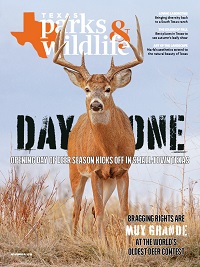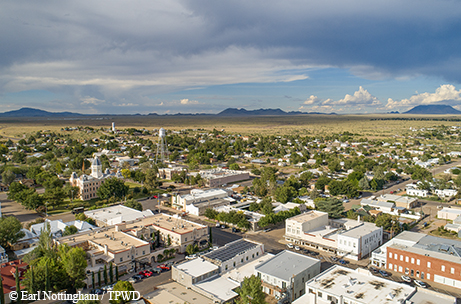
Art of the Landscape
Destination: Marfa
Travel time from:
Lubbock – 4.5 hours
Dallas – 7.5 hours
El Paso – 3 hours
Austin – 6.5 hours
Houston – 9 hours
Brownsville – 9.5 hours
Marfa's aesthetics extend to the natural beauty of West Texas.
By Melissa Gaskill
As Jeffrey Hester maneuvers his dusty SUV down the unpaved road, I notice the navigation panel on the dash is completely blank. We have literally driven off the map. Nice.
He stops and points toward a deep, rugged canyon.
“From town, you’d never know these canyons and peaks are even here,” he tells me. “It looks like the Earth just falls off.”

An aerial view of Marfa.
Hester started his guiding company, Rangefinder West Texas Expeditions, so visitors to Marfa wouldn’t miss landscapes like this one. We start the day with a cup of Big Bend Coffee Roasters brew at Marfa’s Frama, a combination coffee shop/ice cream shop/laundry, the sort of amalgamation that raises no eyebrows here. Then we head south on U.S. Highway 67, a road lined with open, grassy pastures, past Cibolo Creek Ranch and through the mining ghost town of Shafter to the river road, aka FM 170. Going northwest, it winds and undulates along the backside of the Chinati Mountains, through creosote bushes and past increasingly rugged washes to Ruidosa, a tiny town where the pavement ends. We pass a single vehicle in these 36 miles and spot a sizable bobcat in an arroyo.
Hester pulls into the Hot Springs Airport General Store, which bills itself as the most remote bar in Texas and sells the only groceries available within 50 miles. Jennifer Weaver put up the building to make and sell her handmade leather goods — handbags, wallets, journal covers — and added basic food and hardware items when the grocery in Ruidosa closed, then a bar when the town lost its cantina. The store serves as a local gathering spot as well as office for the airport, a wide strip in the cactus on higher ground a few miles away. About 10 planes land here each month.
Suitably provisioned with cold drinks, we take Ranch Road 2810, Pinto Canyon Road, rising up to a plateau offering sightings of 7,730-foot Chinati Peak. A small cemetery on a high point proves the perfect spot for a tailgate picnic — breeze and view, no extra charge. The road threads a pass in the mountains, passing the airstrip, Chinati Hot Springs resort and more tiny cemeteries. We cross deep, narrow canyons, and the landscape grows more rugged. Ocotillo, sotol, yucca and cholla dot the slopes, and we scare up a couple of jackrabbits and a caracara.
“If you come here and don’t see all this, you’ve done yourself a disservice,” Hester says. “I love the diversity of the landscape. There is art in town, but the real art is out here.”

Jeffrey Hester of Rangefinder West Texas Expeditions.
The art in town enjoys quite a reputation, but I came for the “out here” art, and Hester delivers. Most of his driving tours take a day, some less depending on destination, and his offerings include sunset rides to the canyon and pickup from the Alpine Amtrak station, the El Paso or Midland-Odessa airports and airstrips in Marfa, Presidio and Alpine. While today we stop often to wander, driving tours are ideal for those who want to just sit back and take it all in.
Hester studied fine arts in college and worked in advertising for about 12 years. He drove through Marfa once on his way to a job in San Diego.
“I spent one night here and couldn’t get it out of my mind all winter: the vibe, the landscape,” he says. “So, I came back in summer.”
He befriended locals and visited every place they told him about before opening Rangefinder in April 2017 as a way to share his experiences discovering the area.
“There is so much out there to see,” he says. “The whole idea of the company is getting people not only to Marfa but to show them how, in any direction, everything is so different — the geology, landscape, wildlife.”
Back in town, I head to my room at Hotel Paisano to wash off the dust before dinner. Designed by famed architect Henry Trost, it opened in 1930, an elegant two-story stucco and tile building of 65 rooms, each with private bath. In the summer of 1955, the hotel served as headquarters for the cast of the iconic Texas film Giant, including stars Elizabeth Taylor, Rock Hudson and James Dean. Today, the sunny lobby features beautiful tile, taxidermy longhorns and historic photos from the movie. A tall fountain splashes in the sunny outdoor courtyard, and an indoor lounge area sports a deep leather sofa and fireplace.

Hotel Paisano.
At the Capri restaurant in town, we dig into a plate of Island Creek oysters served with prickly pear mignonette, a seaweed salad and a 50-ounce rib-eye, sliced into enough succulent pieces for Hester, me and everyone we passed on the road today. A tall wall of windows overlooks an outdoor area with clusters of seating, firepits and mostly native landscaping.
West Texas native and art aficionado Virginia Lebermann had a hand in the Thunderbird Hotel that opened across the street in 2005 and runs the restaurant with husband and chef Rocky Barnette. The oysters are clearly fresh and full of taste, as is the slightly tangy salad. The rib-eye is Texas-grown Akaushi, a Japanese red Wagyu breed of beef cattle. Thanks to excellent food and drink on top of a busy day, I fall asleep almost before my head hits the oversized pillow on my Paisano bed.
The next morning, I’m ready for a hike. Marfa sits within driving distance of many miles of trails in Big Bend National Park, Big Bend Ranch State Park, Davis Mountains State Park, the Chihuahuan Desert Nature Center and elsewhere. Hester’s favorites are the South Rim and the Chimneys in the national park, but with only a half-day to spare, I head the other direction, to Madera Canyon Trail in the Nature Conservancy’s Davis Mountains Preserve. These 33,075 acres protect part of the Davis Mountains sky island — a cooler, wetter landscape surrounded by arid lowland desert. The area contains plants rare in the state, such as ponderosa pine, pinyon pine, mountain mahogany and madrone trees. The 2.4-mile loop trail begins in the canyon at the Lawrence E. Wood Picnic Area on Texas Highway 118, 24 miles northwest of Fort Davis. It crosses Madera Creek and takes me across grassland and through forests of pinyon, oak and juniper, at one point offering a glimpse of Mount Livermore. At 8,378 feet, the peak ranks as the fifth highest in Texas.
Texas Highways 118 and 166 form a loop out of Fort Davis known as the Scenic Loop. On the advice of Tara Poloskey, the Nature Conservancy’s education and outreach coordinator for West Texas, I take a detour on Ranch Road 505, which cuts down to U.S. Highway 90. Poloskey calls this stretch “hawk alley” for its frequent sightings of golden eagles, red-tailed hawks and other raptors.
Back in Marfa, I meet Hester at Buns N’ Roses, which serves breakfast and lunch. Then we swing by the courthouse, climbing a series of beautiful wooden stairs to a cupola atop the building to take in an expansive view of town and beyond. Established in 1883 as a water stop for the railroad, Marfa became the Presidio County seat in 1885. This three-story Renaissance-revival courthouse, built in 1886, got a makeover in 2001.

Marfa Public Radio serves West Texas listeners.
After a cold drink in the bar at Hotel Saint George, we walk around the block to Cobra Rock to admire leather goods designed and made by Colt Miller and Logan Caldbeck in the shop using American leather. Miller grew up south of Lubbock; British Columbia native Caldbeck originally came to Marfa to take a job at the art-focused Chinati Foundation. Both now devote full time to Cobra Rock, which, in addition to Western-inspired, fashionable desert boots, also carries accessories and products from other independent designers and made-in-the-U.S. brands.
Next stop, Spare Parts and Ranch Candy, where jars full of colorful treats cover a table beneath some of Hester’s art: images of barbed wire, antelope and cacti painted on squares of rough wood. I admire the funky Western-themed art, clothing, hats and jewelry, displayed in a very Marfa-esque style, hanging on Topo Chico bottles (no shortage of those around here).
The trip ends with a final Marfa meal at Convenience West BBQ, which serves Friday through Sunday from 5 to 7 p.m. or “until we run out.” Tantalizing aromas waft from a large pit in front of the former gas station; large picnic tables fill the inside. I order a brisket plate with sweet potato salad and box up several generous slices of tender brisket for snacking on the drive home.
Hester, who hails from a small Georgia town, has lived in New York, Los Angeles, San Francisco and Atlanta and worked briefly in a half-dozen other cities.
“But,” he professes, “I’ve never felt more at home than here in Marfa.”
Now he wants to make others feel at home here, too.
More Info: |
» Like this story? If you enjoy reading articles like this, subscribe to Texas Parks & Wildlife magazine.
Related stories
See more travel stories on TP&W magazine's Travel page

